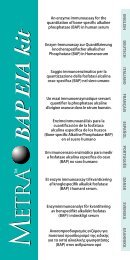Clinical and Technical Review - Tecomedical
Clinical and Technical Review - Tecomedical
Clinical and Technical Review - Tecomedical
Create successful ePaper yourself
Turn your PDF publications into a flip-book with our unique Google optimized e-Paper software.
Figure 1:<br />
Soloway 0 = Patients without bone metastasis<br />
Soloway 1 = Patients with < 6 bone metastases<br />
Soloway 2 = Patients with < 20 bone metastases<br />
Soloway 3 = Patients with > 20 bone metastases but less<br />
than a “super scan”<br />
Soloway 4 = Patients with “super scan” that is defined by<br />
a > 75 % involvement of the ribs, vertebrae<br />
<strong>and</strong> pelvic bones<br />
Relative increases in bone resorption, bone formation, <strong>and</strong><br />
osteoclastogenesis marker as a function of the extent of skeletal<br />
involvement assessed in 132 breast <strong>and</strong> prostate cancer<br />
patients. Relative increases are expressed as percentage of<br />
levels in patients with Soloway score 0 (1) .<br />
Currently, the diagnosis of bone metastasis in cancer<br />
patients relies predominantly on imaging techniques,<br />
such as plain radiography or Technetium-99 scintigraphy.<br />
Although scintigraphy is more sensitive than plain<br />
radiography <strong>and</strong> even can give quantitative information<br />
regarding skeletal involvement, this examination is also<br />
more expensive, invasive, time-consuming <strong>and</strong> exposes<br />
cancer patients to irradiation, limiting its use for monitoring<br />
purposes. Thus, these weaknesses of current methodologies<br />
point out an unmet need for establishing supplementary<br />
diagnostic tools like biochemical marker.<br />
Regulators of bone turnover<br />
Bone remodeling is an ongoing dynamic process<br />
consisting of bone resorption (due to osteoclasts digesting<br />
type I collagen) <strong>and</strong> bone formation (due to osteoblasts).<br />
Normally, these processes are balanced, resulting in 10 %<br />
replacement of the skeleton, each year. However, due to<br />
aging, disease or other conditions, bone turnover may<br />
become imbalanced where bone resorption <strong>and</strong> formation<br />
occur at different rates.<br />
OPG (Osteoprotegerin), also known as osteoclast inhibiting<br />
factor (OCIF), inhibits the differentiation <strong>and</strong> activation of<br />
osteoclasts.<br />
On the other h<strong>and</strong>, sRANKL (soluble receptor activator of<br />
nuclear factor (NF)-κB lig<strong>and</strong>) is the main stimulator for the<br />
formation of mature osteoclasts. Stimulation occurs through<br />
binding of sRANKL to the osteoclastic membrane receptor<br />
RANK.<br />
OPG inhibits the binding of sRANKL to RANK <strong>and</strong> thus<br />
the activation of osteoclasts. The OPG/sRANKL system is<br />
therefore a key regulator of bone resorption. Abnormalities<br />
in the balance of the OPG/sRANKL system may be the<br />
cause of bone loss in many metabolic bone diseases as<br />
osteoporosis, Paget’s disease, metastatic cancers <strong>and</strong><br />
rheumatic bone degradation.<br />
In normal healthy people, sRANKL levels are generally low<br />
because the majority is bound by OPG. Decreased levels of<br />
OPG <strong>and</strong>/or increased levels of sRANKL may indicate an<br />
imbalance of the OPG/sRANKL system.<br />
OPG <strong>and</strong>/or sRANKL measurements can<br />
be used as an aid in determining the cause<br />
of bone loss by assessing imbalances in<br />
the OPG/sRANKL system in:<br />
• Post menopausal osteoporosis<br />
• Paget’s disease<br />
• Metastatic cancer<br />
• Diseases with locally increased resorption activity<br />
• Indicating bone loss in rheumatoid arthritis<br />
• Therapy monitoring after treatment with OPG<br />
• Determining an imbalance in vascular calcification (high<br />
OPG was associated with cardiovascular- <strong>and</strong> all-cause<br />
mortality in hemodialysis patients; Morena et al. 2006).<br />
• Metastatic Renal Cell Carcinoma (OPG)<br />
3



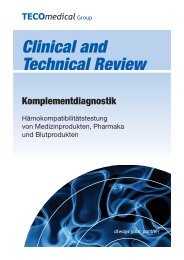
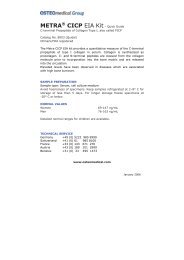
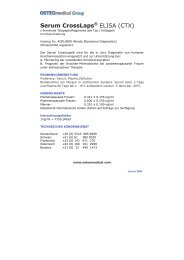
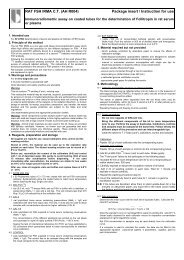


![PTH [Hormone Parathyroïdienne] Intacte ELISA](https://img.yumpu.com/1233682/1/190x245/pth-hormone-parathyroidienne-intacte-elisa.jpg?quality=85)
